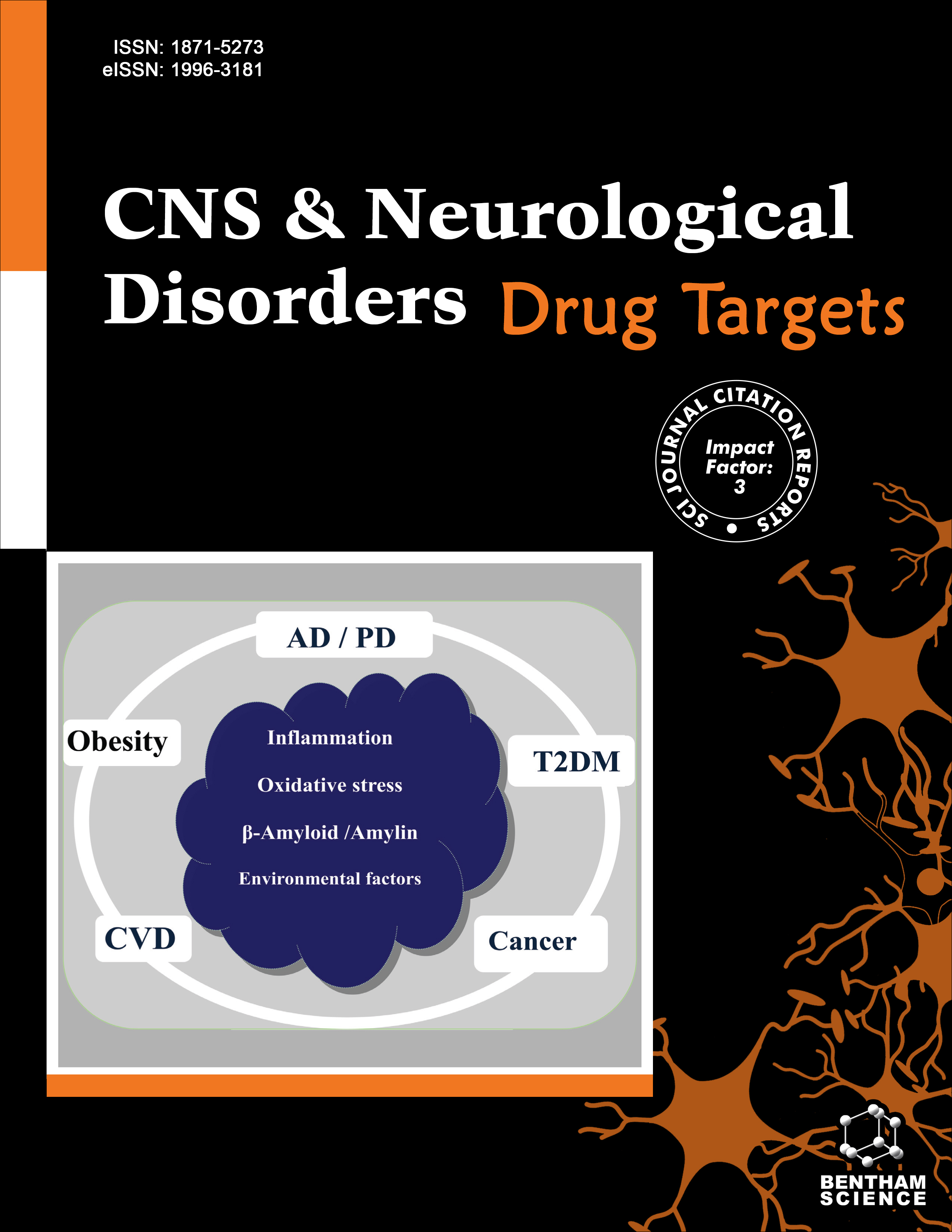- Home
- A-Z Publications
- CNS & Neurological Disorders - Drug Targets (Formerly Current Drug Targets - CNS & Neurological Disorders)
- Previous Issues
- Volume 18, Issue 2, 2019
CNS & Neurological Disorders - Drug Targets (Formerly Current Drug Targets - CNS & Neurological Disorders) - Volume 18, Issue 2, 2019
Volume 18, Issue 2, 2019
-
-
New Drug Discovery from Medicinal Plants and Phytoconstituents for Depressive Disorders
More LessAuthors: Fatma Tuğçe Gürağaç Dereli, Mert Ilhan and Esra Küpeli AkkolBackground & Objective: Depression, a risk factor for several serious diseases, is a highly prevalent and life-threatening psychiatric disorder. It can affect the individual’s position in life and reduce the living standards. The research on the use of medicinal plants in treating this disease has increased enormously because of the possible low rehabilitation rate and side effects of available synthetic drugs, such as sexual dysfun Read More
-
-
-
A Pharmacological Appraisal of Neuroprotective and Neurorestorative Flavonoids Against Neurodegenerative Diseases
More LessAuthors: Jia Zhao, Mengxia Zhu, Mukesh Kumar, Fung Y. Ngo, Yinghui Li, Lixing Lao and Jianhui RongBackground & Objective: Alzheimer’s disease (AD) and Parkinson’s disease (PD) affect an increasing number of the elderly population worldwide. The existing treatments mainly improve the core symptoms of AD and PD in a temporary manner and cause alarming side effects. Naturally occurring flavonoids are well-documented for neuroprotective and neurorestorative effects against various neurodegenerative diseases. Read More
-
-
-
Xuesaitong May Protect Against Ischemic Stroke by Modulating Microglial Phenotypes and Inhibiting Neuronal Cell Apoptosis via the STAT3 Signaling Pathway
More LessAuthors: Fangfang Li, Haiping Zhao, Ziping Han, Rongliang Wang, Zhen Tao, Zhibin Fan, Sijia Zhang, Guangwen Li, Zhigang Chen and Yumin LuoBackground: Xuesaitong mainly comprises Panax notoginseng saponins and has shown a promising feature in an acute ischemic stroke model; however, its effect on long-term recovery following stroke, and the related mechanisms, are unknown. Methods: The objective of this study was to investigate the long-term protective effects of xuesaitong against ischemic stroke and its effect on microglial polarization. Experimental Read More
-
-
-
A New Schizophrenia Model: Immune Activation is Associated with the Induction of Different Neurotoxic Products which Together Determine Memory Impairments and Schizophrenia Symptom Dimensions
More LessObjective: Recently, we reported that stable-phase schizophrenia is characterized by two interrelated symptom dimensions: PHEMN (psychotic, hostility, excitation, mannerism and negative symptoms); and DAPS (depressive, anxiety and physio-somatic symptoms) and that Major Neuro-Cognitive psychosis (MNP) is the full-blown phenotype of schizophrenia (largely overlapping with deficit schizophrenia). Herein we exami Read More
-
-
-
Generation and Characterization of a Functional Nanobody Against Inflammatory Chemokine CXCL10, as a Novel Strategy for the Treatment of Multiple Sclerosis
More LessBackground & Objective: Chemokines and their receptors play a pivotal role in the pathogenesis of various autoimmune diseases such as multiple sclerosis, infectious diseases, and also in cancer metastasis via attraction of the pathogenic immune cells into the inflammation sites. Methods: Inflammatory chemokine CXCL10 as a T helper (Th)1-chemokine directs chemotaxis of many cell subsets especially Th1 into the central Read More
-
-
-
Cytarabine and Ferric Carboxymaltose (Fe+3) Increase Oxidative Damage and Alter Serotonergic Metabolism in Brain
More LessBackground & Objective: The purpose of this study was to measure the effect on brain biomarkers after treatment with anticancer compounds - cytarabine (CT) and ferric carboxymaltose (FC) (Fe+3) in Wistar rats. Methods: The Wistar rats were treated as follows: group 1 (control), NaCl 0.9%; group 2, CT (25 mg/k), group 3, FC(Fe+3) (50 mg/k) and group 4, CT + FC(Fe+3). The animals were sacrificed and their brains wer Read More
-
-
-
Effects of Exercise and Ferulic Acid on Alpha Synuclein and Neuroprotective Heat Shock Protein 70 in An Experimental Model of Parkinsonism Disease
More LessBackground & Objective: This study investigated the effects of ferulic acid (FR), muscle exercise (Ex) and combination of them on rotenone (Rot)-induced Parkinson disease (PD) in mice as well as their underlying mechanisms. Method: 56 male C57BL/6 mice were allocated into 8 equal groups, 1) Normal control (CTL), 2) FR (mice received FR at 20 mg/kg/day), 3) Ex (mice received swimming Ex) and 4) Ex + FR (mice received FR Read More
-
Volumes & issues
-
Volume 24 (2025)
-
Volume 23 (2024)
-
Volume 22 (2023)
-
Volume 21 (2022)
-
Volume 20 (2021)
-
Volume 19 (2020)
-
Volume 18 (2019)
-
Volume 17 (2018)
-
Volume 16 (2017)
-
Volume 15 (2016)
-
Volume 14 (2015)
-
Volume 13 (2014)
-
Volume 12 (2013)
-
Volume 11 (2012)
-
Volume 10 (2011)
-
Volume 9 (2010)
-
Volume 8 (2009)
-
Volume 7 (2008)
-
Volume 6 (2007)
-
Volume 5 (2006)
Most Read This Month
Article
content/journals/cnsnddt
Journal
10
5
false
en

Most Cited Most Cited RSS feed
-
-
A Retrospective, Multi-Center Cohort Study Evaluating the Severity- Related Effects of Cerebrolysin Treatment on Clinical Outcomes in Traumatic Brain Injury
Authors: Dafin F. Muresanu, Alexandru V. Ciurea, Radu M. Gorgan, Eva Gheorghita, Stefan I. Florian, Horatiu Stan, Alin Blaga, Nicolai Ianovici, Stefan M. Iencean, Dana Turliuc, Horia B. Davidescu, Cornel Mihalache, Felix M. Brehar, Anca . S. Mihaescu, Dinu C. Mardare, Aurelian Anghelescu, Carmen Chiparus, Magdalena Lapadat, Viorel Pruna, Dumitru Mohan, Constantin Costea, Daniel Costea, Claudiu Palade, Narcisa Bucur, Jesus Figueroa and Anton Alvarez
-
-
-
- More Less

